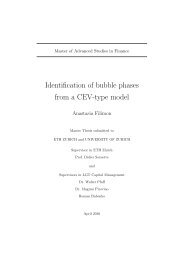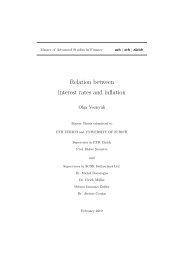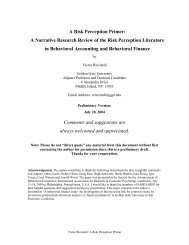Tail Dependence - ETH - Entrepreneurial Risks - ETH Zürich
Tail Dependence - ETH - Entrepreneurial Risks - ETH Zürich
Tail Dependence - ETH - Entrepreneurial Risks - ETH Zürich
You also want an ePaper? Increase the reach of your titles
YUMPU automatically turns print PDFs into web optimized ePapers that Google loves.
Setting all the xi’s but one to +∞ in equation (2.3) yields:<br />
n<br />
lim Fi (an,i + bn,i · xi) = Gi (xi) , fori = 1, . . ., d, (2.7)<br />
n→∞<br />
where Fi and Gi are the i-th marginals of F and G. In turn Fi ∈ MDA (Gi), where Gi<br />
is a Gumbel, Fréchet, or Weibull distribution 1 .<br />
In order to isolate the dependence features from the marginal distribution aspects [6]<br />
(2000), traditionally the components of both the distribution F and the corresponding<br />
MEV distribution G are transformed to standard marginals. It is customary to choose<br />
the standard Fréchet distribution as marginals i.e. the function φ : R → [0, 1] given<br />
by φ(x) = exp � �<br />
−1 for x > 0 and zero elsewhere and by its inverse function: y =<br />
x<br />
φ−1 (x) = −1/ log(x), where ’log’ denotes the natural logarithm. Defining X as a<br />
d-variate random row-vector with distribution F and continuous marginals<br />
Y = φ −1 1<br />
(F(X)) = − , (2.8)<br />
log F(X)<br />
i.e. Yi = φ−1 (Fi(Xi)) = −1/ log F(Xi) for all i ≤ 1 ≤ d. By the Probability Integral<br />
Transform it follows that Y has standard Fréchet marginals. Letting G be a<br />
multivariate distribution with continuous marginals Gi’s and defining:<br />
G ∗ �� � (−1) � � �<br />
(−1)<br />
−1<br />
−1<br />
(y1, . . .,yd) = G<br />
· yi, . . .,<br />
· yd , (2.9)<br />
log G1<br />
log Gd<br />
with y1 > 0, . . .,yd > 0, then G ∗ has standard Fréchet marginals, and G is a MEV distribution<br />
only if G ∗ is also MEV distributed. Thus the marginals of a MEV distribution<br />
can be standardized, yet preserving the extreme value properties.<br />
2.2 The Survival Function<br />
The survival function F associated with multivariate extreme value theory is given by:<br />
F = Pr {X1 > x1, . . .,Xd > xd} (2.10)<br />
In the univariate case d = 1 F = 1 − F(x). Unfortunately this does not hold generally<br />
in multivariate EVT [5] (1988).<br />
2.3 Multivariate <strong>Dependence</strong><br />
In the multivariate case the notions of dependence becomes numerous and complex.<br />
Below we introduce some basic concepts. For further information about how to measure<br />
dependence between random variables we refer to [7] (2006), [8] (2001), and [9] (1997).<br />
2.3.1 Positive Orthant <strong>Dependence</strong><br />
Assuming that X = (X1, . . .,Xd) is a d-variate random row-vector, X is positively<br />
lower orthant dependent (PLOD), if for all x = (x1, . . .,xd) ∈ R d ,<br />
Pr {X ≤ x} ≥<br />
d�<br />
Pr {Xi ≤ xi} (2.11)<br />
i=1<br />
1 This is shown in Theorem 1.7 of chapter 1.2 of [3] (2007)<br />
6








